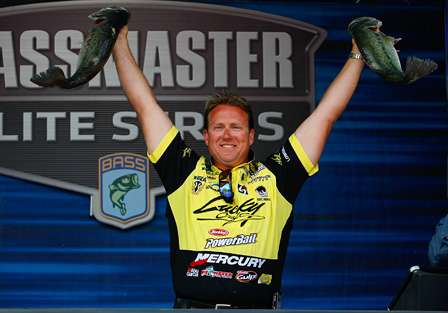
The issue facing the anglers at the Southern Challenge wasn't catching bass. That was easy enough for most of them. The real problem was how to cull out the little ones while preserving the big ones. Not surprisingly, the better anglers rose to the occasion.
Here's how they tell the story:
Skeet Reese
(1st place — 100 pounds, 13 ounces)
Skeet Reese was unavailable for comment.
Davy Hite
(2nd place — 93 pounds, 3 ounces)
Offshore creek channel turns and main river ledges were my best producers. All of them were between 8 and 15 feet deep. The better ones had some cover on them, but the real key was the change in direction of the channel or the change in depth. The better schools seemed to want a change of contour under them.
Mop Jigs, a 12-inch Yamamoto worm and a Carolina rigged lizard all played a part in my catch. My main bait was a Strike King Pro-Model Series 6XD crankbait, however. This was definitely a crankbait tournament, at least for me. And I'm telling you right now, that's one heck of a deep crankbait.
I cranked it with a stop-and-go retrieve at a medium or medium-fast speed on a 7 foot, 4 inch All Star Crankbait Rod and an Abu Garcia Revo Winch reel (5.4:1 gear ratio) spooled with 12-pound-test Berkley Trilene 100% Fluorocarbon line.
All my bass were postspawn, but I have to say they were fat and slick. I caught two over 7 pounds and they looked to be a long ways from their spawn. If I didn't know better, I'd say they were prespawn.
If I made a mistake it was spending too much time looking for my fish the last day. My best school moved on me overnight. I should have fished somewhere else instead of spending so much time hoping their bite would turn on. At the time I thought I should stay, however.
But, that's all hindsight. If they had started biting, I'd be talking about patience being the key. Hindsight is always 20/20, you know.
John Crews
(3rd place — 92 pounds, 11 ounces)
All my bass came from hard-bottom areas along breaks. I found most of those with my crankbait. I'd follow a break, casting as I went along, until I started catching bass. Then I'd look closer and find the irregularity that was holding the school. Every good spot I found was 10 to 17 feet deep.
My bait this week was a Spro Little John DD with a Cell Mate finish. I cranked it pretty hard so that it would dig into the bottom. They were really mauling it. This was a hot bite tournament. It was really wild.
My rod was a custom-made 7 foot, 10 inch JB Custom Rods Deep Crankbait Rod made to handle deep diving crankbaits like the Little John DD. I used a Team Daiwa Zillion Crazy Cranker reel (4.9:1 gear ratio) and 12-pound-test Vicious Fluorocarbon line.
This was a tournament where you couldn't afford to spend much time looking for the bite. The bass are everywhere in Guntersville. They're biting somewhere. You have to go find that bite. Waiting for a particular school to turn on is a waste of time.
That sounds easy to do, but it really isn't. It's hard to leave a place where you've been catching bass. It's natural to think they'll start biting. But on Guntersville you need to keep moving until you find the ones that are hungry.
Paul Elias
(Big bass — 8 pounds, 2 ounces)
I caught her on the lip of a shale bar, about 18 feet deep, the last day of the tournament. She grabbed a blueback/pearl deep diving crankbait. I knew from past experience that I was on a big bass spot. Incredibly, I lost one about the same size from the same spot just a few minutes after I landed her.
My rod was a 7 foot, 11 inch Pinnacle model (medium action) with a Pinnacle reel (5:1 gear ratio) spooled with 12-pound-test Berkley Trilene 100% Fluorocarbon line. (The rod and reel are prototypes. They are not yet being offered to the public for sale.)
